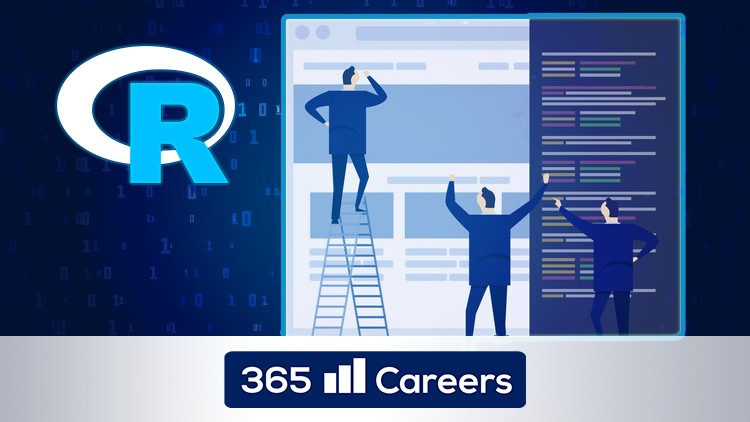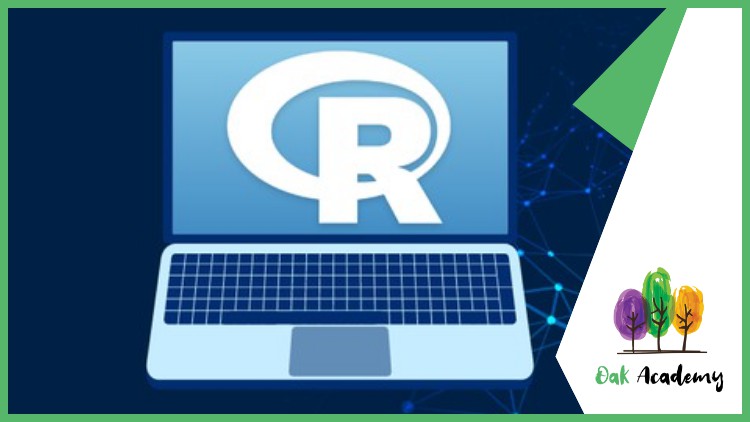Course overview
- Provider
- Udemy
- Course type
- Paid course
- Level
- All Levels
- Duration
- 3 hours
- Lessons
- 33 lessons
- Certificate
- Available on completion
- Course author
- Oak Academy
-
- R and R Studio Installation, R programming, R language
- R Console
- R Studio
- Data Types in R
- Operators and Functions in R
- R Packages
- Managing R Packages
- Data Management in R
- Getting Data into R
- Computation and Statistics
- Hands on r programming language Projects
- R (programming language)
- r programming
- r language
- Learning R from a top-rated OAK Academy's instructor will give you a leg up in either industry
- R is the programming language of choice for statistical computing. Machine learning, data visualization, and data analysis projects increasingly rely on R.
- The R programming language was created specifically for statistical programming. Many find it useful for data handling, cleaning, analysis, and representation.
- R is a popular programming language for data science, business intelligence, and financial analysis. Academic, scientific, and non-profit researchers use the R
- Whether R is hard to learn depends on your experience. After all, R is a programming language designed for mathematicians, statisticians, and business analysts
- Python vs. R: What is the Difference? Python and R are two of today's most popular programming tools.
- What careers use R? R is a popular programming language for data science, business intelligence, and financial analysis.
Description
Hi there,
Welcome to my “R For Beginners: Learn R Programming from Scratch” course.
R, r programming, r language, data science, machine learning, r programming language, r studio, data analytics, statistics, data science, data mining, machine learning
R Programming in R and R Studio, analyze data with R (programming language) and become professional at data mining
Machine learning and data analysis are big businesses. The former shows up in new interactive and predictive smartphone technologies, while the latter is changing the way businesses reach customers. Learning R from a top-rated OAK Academy's instructor will give you a leg up in either industry.
R is the programming language of choice for statistical computing. Machine learning, data visualization, and data analysis projects increasingly rely on R for its built-in functionality and tools. And despite its steep learning curve, R pays to know.
In this course, you will learn how to code with R Programming Language, manage and analyze data with R programming and report your findings.
R programming language is a leading data mining technology. To learn data science, if you don’t know which high return programming language to start with. The answer is R programming.
This R programming course is for:
Students in statistical courses R (programming language),
Analysts who produce statistical reports,
Professional programmers on other languages,
Academic researchers developing the statistical methodology,
Specialists in the various area who need to develop sophisticated graphical presentations of data,
and anyone who is particularly interested in big data, machine learning and data intelligence.
No Previous Knowledge is needed!
This course will take you from a beginner to a more advanced level.
If you are new to data science, no problem, you will learn anything you need to start with R.
If you are already used to r statics and you just need a refresher, you are also in the right place.
Here is the list of what you’ll learn by the end of the course,
· Installation for r programming language
· R Console Versus R Studio
· R and R Studio Installation in r shiny
· Basic Syntax in r statistics
· Data Types in R shiny
· Operators and Functions in R
· R Packages in data analytics
· Managing R Packages in r language
· Data Management in R
· Getting Data into R in machine learning
· Computation and Statistics in data science
· Hands-on Projects Experimental Learning in r programming
R programming language
R
R language
After every session, you will have a strong set of skills to take with you into your Data Science career.
So, This is the right course for anyone who wants to learn R from scratch or for anyone who needs a refresher.
Fresh Content
What is R and why is it useful?
The R programming language was created specifically for statistical programming. Many find it useful for data handling, cleaning, analysis, and representation. R is also a popular language for data science projects. Much of the data used for data science can be messy and complex. The programming language has features and libraries available geared toward cleaning up unorganized data and making complex data structures easier to handle that can't be found in other languages. It also provides powerful data visualization tools to help data scientists find patterns in large sets of data and present the results in expressive reports. Machine learning is another area where the R language is useful. R gives developers an extensive selection of machine learning libraries that will help them find trends in data and predict future events.
What careers use R?
R is a popular programming language for data science, business intelligence, and financial analysis. Academic, scientific, and non-profit researchers use the R language to glean answers from data. R is also widely used in market research and advertising to analyze the results of marketing campaigns and user data. The language is used in quantitative analysis, where its data analysis capabilities give financial experts the tools they need to manage portfolios of stocks, bonds, and other assets. Data scientists use R in many industries to turn data into insights and predict future trends with its machine learning capabilities. Data analysts use R to extract data, analyze it, and turn it into reports that can help enterprises make better business decisions. Data visualization experts use R to turn data into visually appealing graphs and charts.
Is R difficult to learn?
Whether R is hard to learn depends on your experience. After all, R is a programming language designed for mathematicians, statisticians, and business analysts who may have no coding experience. For some beginning users, it is relatively simple to learn R. It can have a learning curve if you are a business analyst who is only familiar with graphical user interfaces since R is a text-based programming language. But compared to other programming languages, users usually find R easier to understand. R also may have an unfamiliar syntax for programmers who are used to other programming languages, but once they learn the syntax, the learning process becomes more straightforward. Beginners will also find that having some knowledge of mathematics, statistics, and probabilities makes learning R easier.
It’s no secret how technology is advancing at a rapid rate. New tools are released every day, and it’s crucial to stay on top of the latest knowledge. You will always have up-to-date content to this course at no extra charge.
What is Python?
Python is a general-purpose, object-oriented, high-level programming language. Whether you work in artificial intelligence or finance or are pursuing a career in web development or data science, Python is one of the most important skills you can learn. Python's simple syntax is especially suited for desktop, web, and business applications. Python's design philosophy emphasizes readability and usability. Python was developed on the premise that there should be only one way (and preferably, one obvious way) to do things, a philosophy that resulted in a strict level of code standardization. The core programming language is quite small and the standard library is also large. In fact, Python's large library is one of its greatest benefits, providing different tools for programmers suited for a variety of tasks.
Python vs. R: what is the Difference?
Python and R are two of today's most popular programming tools. When deciding between Python and R, you need to think about your specific needs. On one hand, Python is relatively easy for beginners to learn, is applicable across many disciplines, has a strict syntax that will help you become a better coder, and is fast to process large datasets. On the other hand, R has over 10,000 packages for data manipulation, is capable of easily making publication-quality graphics, boasts superior capability for statistical modeling, and is more widely used in academia, healthcare, and finance.
Video and Audio Production Quality
All our contents are created/produced as high-quality video/audio to provide you with the best learning experience.
You will be,
· Seeing clearly
· Hearing clearly
· Moving through the course without distractions
You'll also get:
Lifetime Access to The Course
Fast & Friendly Support in the Q&A section
Udemy Certificate of Completion Ready for Download
Dive in now!
R For Beginners: Learn R Programming from Scratch
We offer full support, answering any questions.
See you in the course!
Similar courses

-
6 hours
-
53 lessonsCertificate

-
11 hours
-
82 lessonsCertificate


